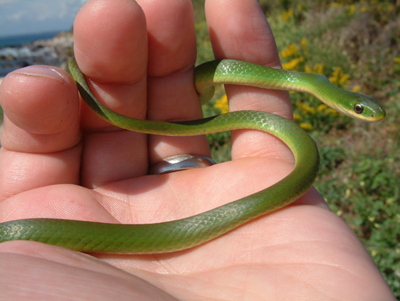Chaplin, CT--Rusty Lanzit is in his element here beside the Natchaug River where it runs past his Christmas tree farm. "There's something about living along the water that all of us can appreciate," he says. "Clean air and clean water are what people want."
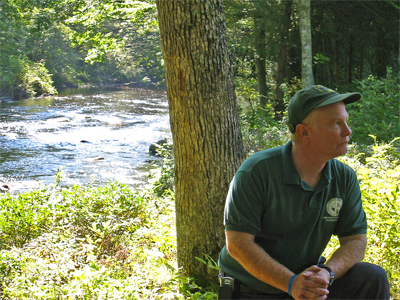
He should know. As First Selectman of Chaplin, Rusty (above) has long been a leader in efforts that communities in eastern Connecticut are undertaking to protect local rivers such as the Natchaug and its headwaters, Bigelow Brook and the Still River.
Seven towns, Ashford, Chaplin, Eastford, Mansfield, Union, Windham and Woodstock marked a milestone earlier this summer when the river system became an
officially designated Connecticut Greenway, the latest of about forty natural areas within Connecticut to be given special status by the state.
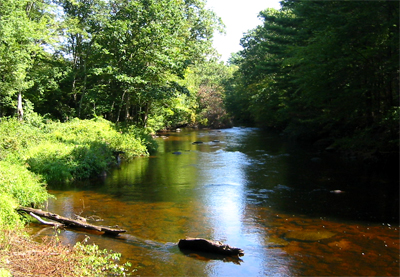
A view of the Natchaug River in late summer (above). The state describes greenways as corridors of open space that may protect natural resources, features, landscapes, views or historic sites and serve to connect protected areas or biotic corridors.
For a municipality to submit an open space corridor for designation it must formally endorse the greenway with a resolution or compact, include it in its Plan of Conservation and Development and agree to undertake improvements. Designation earns communities "bonus points" that can give them a leg up when applying for state grants for projects such as improving trails or habitat or acquiring open space within a greenway system.
Rallying points
While mustering votes for resolutions can be a daunting task, in the Natchaug watershed the process worked to rally support for community-based environmental protection, tapping what many describe as a groundswell. "Development pressure has made [land use] a front burner issue," Rusty says. "Our goal [for the greenway in Chaplin] is to protect and preserve it--and the time is right. We have all our boards involved."
"There has been a tremendous amount of grassroots support for protecting these resources," says Holly Drinkuth, conservation commission liason for the
Green Valley Institute. Holly was the point person on the greenway application and coordinated the towns' efforts to protect the watershed for the past five years. "The designation creates a rallying point and serves to let people know what a wonderful resource we have in the river and what they can do to become part of its protection. Citizen involvement has been terrific."
Holly is well known in eastern Connecticut for her efforts to inform community land use boards and commissions here about landscape-level conservation. On any given day, Holly and her colleague, Steve Broderick, co-director of the Green Valley Institute, may be out surveying local forests, rivers, even roadway storm drain sedimentation around the Quinebaug Highlands region.
By night they can often be found at meetings at one town hall or another, sharing with people who volunteer to serve on local planning, zoning or conservation commissions what they have learned about managing and preserving the rural, pristine nature of the Quiet Corner.
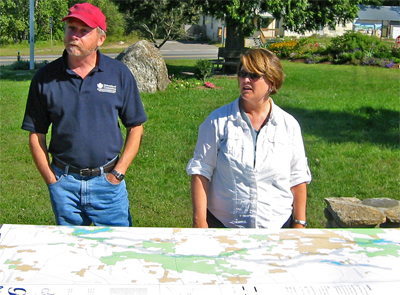
Steve Broderick and Holly Drinkuth (above) pointed out features of the Natchaug River Greenways corridor on a map outside Ashford Town Hall on Thursday.
Waypoints
Community plans to protect the Natchaug watershed began taking shape in 2001 when local leaders such as Rusty and the Green Valley Institute set out to study conservation needs in the Quinebaug Highlands region. "We began to wonder how do we maintain quality forest land?" Holly says. "The quality of the water in rivers in northeastern Connecticut has always been high so another question was how do we protect the quality of our water systems?"
In 2004, Green Valley Institute partnered with
The Nature Conservancy Connecticut to identify essential natural resources in the region and conservation tools that could be used to protect them. Based on findings of its staff scientists in the northeast region, The Nature Conservancy offered answers to key questions. "We began to recognize that you need to protect the rivers that run through the forests to keep the whole system working," says Nature Conservancy Connecticut Chapter Director Lise Hanners.
"What's critically important is that conservation plans are based on science," says Steve. "That's where The Nature Conservancy's ecologists have been so helpful. It's great to talk about protection, but what does that mean? That's what The Nature Conservancy and their scientific resources have been helping us to understand."
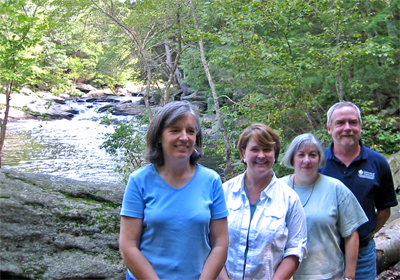
Lise Hanners (The Nature Conservancy Connecticut), Holly Drinkuth (Green Valley Institute), Leslie Lewis (Connecticut DEP/Greenways) and Steve Broderick (Green Valley Institute) at "Diana's Pool" a popular swimming hole on the Natchaug River in Chaplin.
Community-based: going beyond governmental regulation
Since the state officially designated the Natchaug greenway in June, the real work of protection has begun. "In the end it's up to the local communities to assume responsibility and take the lead on protecting the greenway," says Steve.
The reality is that the state designation by itself isn't enough to protect a natural resource or corridor. "It's voluntary," says Leslie Lewis, Greenways Coordinator for the
Connecticut Department of Environmental Protection. "It has no teeth. There are no 'shalts,' only 'shoulds.' I believe the real benefit is that designation can serve as a blueprint for plans of conservation and development without the negative impacts of government overregulation."
"There are opportunities for towns to integrate ideas in the plans with their zoning and conservation work," says Holly. "There is some potential to put in additional restriction such as setbacks, but the real opportunity is for towns to work together to adopt similar strategies and to promote informed, voluntary stewardship."
The idea is to provide people with relevant information, to inform landowners along the river about best practices such as maintaining buffer zones that help cleanse runoff and provide shade that helps keep river water from getting too warm. By fostering a stewardship ethic, a community-based approach can succeed where government regulation often fails.
"The hope is that the guy who has a pile of car batteries in his yard will be made to feel like the outlier," says Steve, "and that we can create an environment where peer pressure and community pressure work to protect natural resources on a voluntary basis.
"And that's a do-able thing, but you have to keep up the drumbeat. It's a continual process of outreach and awareness building. Outreach is a key part of a successful plan."
Steve's insights (and optimism) comes from seeing the results of the outreach work he and Holly have already done, and the knowledge that environmental stewardship has long been a part of the culture of eastern Connecticut. Standing at Diana's Pool, a spot along the Natchaug where legend has it that the forlorn sobs of a broken-hearted Chaplin woman "who jumped to her death in the icy waters" can still be heard, Steve talks about the real tradition of environmental conservation that exists here.
"This is an area that has its roots in private citizen conservation," says Steve. "It's a favorite spot that has been protected since the 1930s, when James L. Goodwin (for whom the state forest and conservation center in Hampton is named) bought the property downriver from an old mill and held it until the state could acquire it. Now we have an opportunity to continue that legacy."
